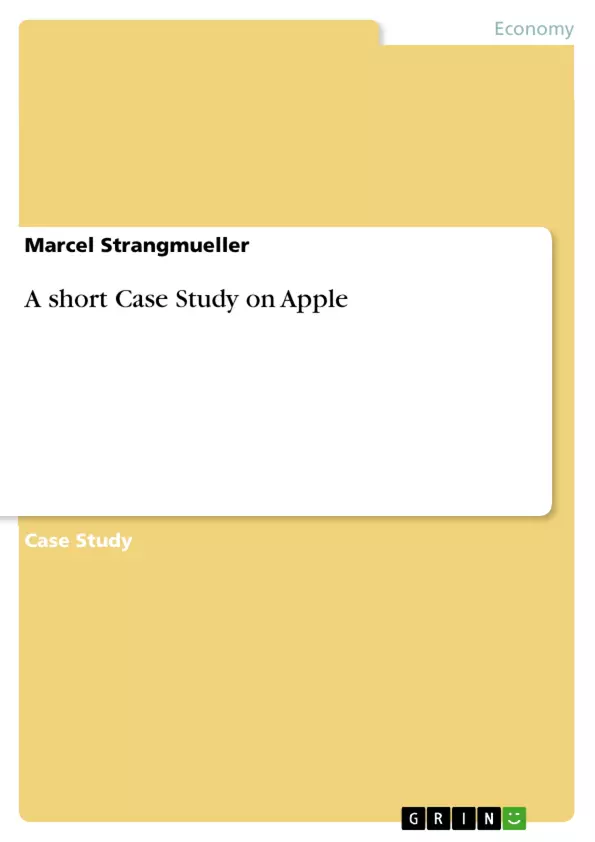To understand how Apple is competing against others, we need to understand firstly what the requirements are to enter the market and how Apple's products differentiate the company from its competition. This Essay explores strategic actions of Apple Inc. and what they have to do with holding their competitive advantage in the market and explains how they achieve to have the best supply chain in the world.
Inhaltsverzeichnis (Table of Contents)
Zielsetzung und Themenschwerpunkte (Objectives and Key Themes)
This case study analyzes Apple's competitive strategies, supply chain management, and future prospects. The analysis explores how Apple differentiates itself from competitors, manages its supply chain for optimal efficiency, and plans for maintaining its competitive edge.
- Apple's competitive strategies in its major markets
- Apple's supply chain design and optimization
- Apple's strategies for maintaining its competitive advantage
- The role of innovation and customer relations in Apple's success
- Apple's expansion into new markets
Zusammenfassung der Kapitel (Chapter Summaries)
QUESTION 1: How does Apple compete in its major markets: iMacs, iPod and iTunes?: This chapter examines Apple's competitive approach, focusing on the concepts of "qualifiers" and "order winners." Apple qualifies its products for the market through quality and premium pricing, meeting market standards while not competing on price alone. Its order-winning strategies center on innovation, exemplified by the rapid and consistent renewal of its product lines (iMacs and iPods), and the provision of innovative services like iTunes, which offered unparalleled ease of access to music. Crucially, Apple's exceptional customer relations and extensive global retail presence, offering support and services directly to customers, significantly differentiate the company and secure its competitive advantage.
QUESTION 2: How has operations designed its supply chain to support these markets?: This section delves into Apple's highly efficient supply chain, recognized as one of the world's best. The key changes implemented by Tim Cook involved drastically reducing the number of suppliers, fostering competition for quality and cost efficiency. Simultaneously, Apple minimized warehousing, resulting in significantly reduced inventory and accelerated turnover. Outsourcing delivery and implementing direct-from-factory shipments eliminated storage time, further optimizing the supply chain. This transformation aligns with principles of strategic operations management, converting a previously disorganized network of entities into a highly integrated and efficient system.
QUESTION 3: What must Apple do to maintain its competitive position in the future?: This chapter discusses the competitive landscape in the technology sector and the strategies Apple must employ for continued success. Apple must maintain its competitive edge through continuous innovation and research to produce new products every 12-18 months. Their strategy involves leveraging their diverse product range and broad customer base to achieve rapid product development and sales. Furthermore, Apple is actively expanding into new markets, including the transportation sector, illustrated by their investment in Didi, a Chinese ride-sharing service. Ultimately, sustaining superior customer service and maintaining their rapid pace of innovation are identified as pivotal to Apple's long-term success.
Schlüsselwörter (Keywords)
Apple, competition, supply chain management, innovation, customer relations, premium pricing, iMac, iPod, iTunes, strategic operations management, market expansion.
Apple Case Study: Competitive Strategies, Supply Chain, and Future Prospects - FAQ
What is the focus of this case study?
This case study analyzes Apple's competitive strategies, supply chain management, and future prospects. It examines how Apple differentiates itself, manages its supply chain for efficiency, and plans for maintaining its competitive edge.
What are the key themes explored in the case study?
Key themes include Apple's competitive strategies in major markets (iMacs, iPods, iTunes), its supply chain design and optimization, strategies for maintaining competitive advantage, the role of innovation and customer relations, and expansion into new markets.
How does Apple compete in its major markets (iMacs, iPod, iTunes)?
Apple uses a combination of "qualifiers" (meeting market standards through quality and premium pricing) and "order winners" (innovation and exceptional customer relations). Its rapid product renewal, innovative services like iTunes, and strong customer support differentiate it and secure its competitive advantage.
How has Apple designed its supply chain to support its markets?
Under Tim Cook's leadership, Apple drastically reduced the number of suppliers, minimized warehousing, and implemented direct-from-factory shipments. This created a highly efficient supply chain with reduced inventory and accelerated turnover, aligning with strategic operations management principles.
What must Apple do to maintain its competitive position in the future?
Apple must continue to innovate and release new products regularly (every 12-18 months). Leveraging its product range and customer base for rapid development and sales, and expanding into new markets (e.g., transportation through investments like Didi) are crucial. Superior customer service and a rapid pace of innovation are key to long-term success.
What are the main competitive strategies employed by Apple?
Apple's competitive strategies revolve around innovation, premium pricing, exceptional customer service, and a highly efficient supply chain. They focus on creating a unique customer experience and consistently delivering new and improved products.
What role does innovation play in Apple's success?
Innovation is central to Apple's success. Continuous product development and the introduction of innovative services are key elements of their competitive strategy, allowing them to maintain a leading position in the market.
What is the significance of Apple's supply chain management?
Apple's supply chain management is considered one of the best in the world. Its efficiency, achieved through strategic supplier relationships, minimized warehousing, and direct-from-factory shipments, directly contributes to its profitability and competitive advantage.
What are the key takeaways from this case study?
The case study highlights the importance of innovation, efficient supply chain management, superior customer service, and strategic market expansion for maintaining a competitive edge in the technology industry. Apple's success serves as a model for other companies.
What keywords are associated with this Apple case study?
Apple, competition, supply chain management, innovation, customer relations, premium pricing, iMac, iPod, iTunes, strategic operations management, market expansion.
- Quote paper
- Marcel Strangmueller (Author), 2017, A short Case Study on Apple, Munich, GRIN Verlag, https://www.grin.com/document/417198



